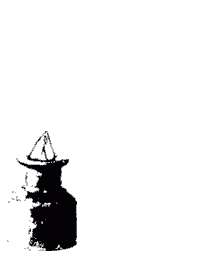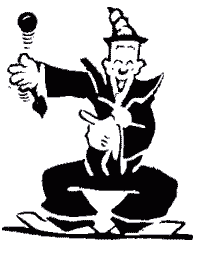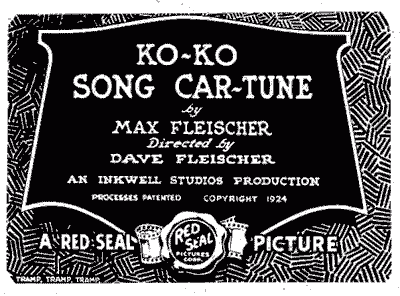Koko and His Bouncing Ball
Koko and His Bouncing Ball
Memories of the sing-along at the movies . . .
Colonel Harry J. Jenkins wrote the following in the October 1969 issue of Theatre Organ Bombarde, the journal of the American Theatre Organ Enthusiasts, later to become the American Theatre Organ Society.
For little more than a decade, the organ-accompanied sing-along captured and held the fancy of the theatre-going public throughout the country. Most organists relied on highly-decorated, hand-colored slides to project the lyrics of the songs onto the screen. But the more adventuresome tried their hands at playing to words on movie film linked with animated cartoons and set to a strict tempo established by the animator. The playing had to be precise.
The most prominent and original of the film sing-alongs were those featuring Koko the clown. He guided and often "stood in" for the famed bouncing ball, which beat out a steady tempo, fast or slow, depending on the speed the silent film projectionist required to get the show out by 10:30 P.M.
To settle any remaining controversy as to whether the "bouncing ball" sing-along cartoon originated in the silent picture days or after the advent of sound films, this writer interviewed Richard Huemer (pronounced humor), the former animator for Max and David Fleischer, the brothers who originated the bouncing ball "car-tunes."
Koko's animator, Richard Huemer, joined the Disney Studios in 1930. He considered his roughest assignment to be the animation he did for the Rite of Spring sequence in Disney's Fantasia.
Richard Huemer lived in North Hollywood, California, and was associated with Walt Disney Studios at the time this article was written. He had entered the motion picture cartoon field in New York as an animator for the Mutt and Jeff cartoons produced by Raoul Barre in 1916.
About this same time, Max Fleischer was producing Out of the Inkwell cartoons where the clown Koko first appeared. When Huemer joined the Fleischers, they were located in an old brownstone building on East 45th Street in New York City. From this location they moved to quarters over a store at the corner of 45th Street and Lexington, diagonally opposite the Grand Central Plaza. It was here that they produced many Inkwell cartoons.
As business improved, they moved to a location upstairs over the notorious Silver Slipper night club, next door to the famous Roseland ballroom and across the street from Moe and Mitchell Mark's Strang Theatre. This studio was at 1600 Broadway in New York City.
The Fleischers had an idea about combining cartoons with songs in an attempt to improve on popular song presentations. They hoped to replace the static song slides used by organists by adding motion to the pictures that appeared on screen during the sing-along. They anticipated, quite correctly, good audience acceptance and participation.
Max and Dave Fleischer were both good "idea" men, but Dave was essentially a "story" man. He plotted the sight gags so prevalent in the cartoons. For example, the words would be introduced by having them slide onto the screen horizontally from right or left while a cartoon character, drawn white on a black background, skipped from word to word in time with the music. Tricks were employed such as having a tree mentioned in the lyric "grow" out of the word, thereby dumping the cartoon figure onto the next word.
Main title of an early Max Fleischer filmed sing-along. This reel presents Tramp, Tramp, Tramp, the Boys are Marching and Pack Up Your Troubles in Your Old Kit Bag. Its proximity to World War I is reflected in the military aspects of the cartoons which accompany the words.
Sometimes the word itself would enlarge, contract, melt and flow away, explode, or turn into an animal, vegetable, or mother-in-law. Always the little cartoon figure would skip, jump, or fall from word to word at the proper tempo to set the pace for the song.
After many conferences with Dick Huemer (by that time their chief animator), the first song cartoon was produced. The title was Oh, Mabel for a song which never went over too well, despite the boost provided by the cartoon novelty. The year was 1924 and Oh, Mabel was premiered at the Circle Theatre on Columbus Circle in New York City.
The Circle Theatre at Columbus Circle in New York City was the "preem" house for the Fleischers' Oh, Mabel song cartoon. The theatre opened in 1906 as a 1400-seat combination vaudeville and burlesque house. The policy was switched to movies in 1909 and about 1912 it was taken over by Marcus Loew.
Around 1913, Loew installed a three-manual classic Moller organ (Opus 2017) with "30 registers." Moller always listed the number of stops (registers) on the console, never the number of ranks, so 30 stop-keys or drawknobs wouldn't make it appear to be very large. Loew's New York organists were forever doomed to play mostly classic Mollers that were installed very early in the cinema era before Marcus Loew discovered Robert Mortons and Wurlitzers.
The Fleischers and Dick Huemer went to the Circle Theatre to check on the audience response. It was overwhelming. The crowd was actually singing with gusto! (The premiere accompaniment was provided by the pit orchestra, although the house was equipped with a Moller organ.) After a tonsil-ripping rendition of Oh, Mabel, the applause was deafening and it carried over into the opening titles of the feature film.
The management, alert to this new novelty, shut down the projector, rewound the song cartoon and re-ran the film. Once more the audience happily joined in singing a loud Oh, Mabel. With such solid evidence of success, the Fleischers returned to their studio to rush more song cartoons into production.
In their ensuing crop of "car-tunes," the Fleischers utilized such standards as In the Shade of the Old Apple Tree, After the Ball, My Chinatown, Tararra-Boom-De-Ay, and My Darling Nellie Gray. Usually, it was one song to the reel and it ran an average of 600 feet -- much shorter than the standard silent 1000-foot reel of film. At the normal silent projection speed of 60 feet per minute, the average song film ran ten minutes.
In sing-a-long presentations, Koko would materialize out of the inkwell and then would be shown in a comedy sequence in which he always landed with a ball in his hand. Koko would bounce the ball and it would hover over the first line of lyrics. The organist or orchestra conductor was poised to start the melody as the ball struck the first word, and from there on the bouncing ball was the conductor. As the ball hopped to the end of a line of words, it would return to the left side in time to catch the first beat of the next line of words. These would appear from below as the first line disappeared above.
Dick Huemer explained that this was achieved by having the lyrics drawn in white letters on a black background, line by line. A flexible card bearing the words was wrapped around an old washing machine drum with the camera facing the front of the drum. The words could be hand-turned up to position. A flat black card, with a small slit to permit the exposure of one line of words at a time, was placed between the camera and the drum.
The bouncing ball effect was achieved by use of a black pointer with a white dot at the end. One of the animators would move the pointer over the words. Another person hummed or played the tune. Another controlled the drum to move the next line into position in front of the slit. As the "music" started, the man with the pointer moved the ball in rhythm over the words with a vertical motion until time to skip to the next word or syllable.
Incidentally, Max and Dave Fleischer originated the "Rotoscope" method of producing cartoons to obtain more smoothness in the actions of Koko. Dave would put on a clown suit and go through the story motions in front of a camera to obtain a silhouette or "photo-figure" film record from which the single line drawing would be copied. Thus, the cartoon characters could be drawn to walk, for example, with the same gait as a human. This method was applied in the late '30s when the Fleischers produced Gulliver's Travels, a color cartoon feature in which the fluidity of motion given pen-and-ink characters was particularly noticeable.
Later, the Walt Disney studios used the Rotoscope technique to obtain smoothness of action in the majority of animated scenes with animals or humans.
History reveals that bouncing ball song cartoons came before sound was introduced in motion pictures. (They were reissued later with sound tracks.) At that time, other film companies copied the idea but without the bouncing ball that was the intellectual property of the Fleischers.
Sometimes these early films sustained damage in projectors and were then sent on to other venues with some frames missing -- something that organists didn't discover until rehearsal -- if there was one. It was a puzzle to follow the ball as it bounced completely past two words to a third, at the expense of a couple of measures of music! Somehow organists managed recovery and the audiences sang along without missing a beat.
Max Fleischer, creator of Koko and a pioneer in the art of the animated cartoon, was a man of many talents. Long before Koko made his first excursion out of the inkwell, Fleischer had produced some of the very first training films ever seen by U.S. Army recruits. Long a member of the Society of Motion Picture Engineers, some fifteen of Fleischer's patents were used by the motion picture industry. His genius combined art, science, philosophy, creative ability, and that all-important ingredient, humor. In later years he served as Art Editor for Popular Science Monthly, and wrote a book titled Noah's Shoes which was described as "an adventure in fantastic realities."
As a film producer, Max Fleischer often tackled difficult and controversial subjects. Once he produced a film explaining Einstein's theory of relativity, and another dealing with Darwin's theory of evolution. He is best remembered for the pleasure that he and his brother Dave brought to motion picture audiences from the early '20s through the late '40s -- a 25-year period when a stream of bouncing ball, Popeye, and Betty Boop cartoons brought laughter and song to motion picture screens. These culminated in Fleischer's two feature-length, color cartoons -- Gulliver's Travels and Mr. Bug Goes to Town.
In Max Fleischer's own words . . .
"I first conceived the idea of the 'bouncing ball' after World War I. In 1917, I 'enlisted' in the United States Army (as a civilian) to perform the duty of training raw recruits. This was accomplished by showing sections of cannons and other firearms on a motion picture screen. Then, with a pointer, directing the recruits attention to the different parts, one at a time, emphasizing the importance of one part in relation to another of the projected drawing. Thus, was born the bouncing ball."
Thanks to Don Malkames for the animation frames from his print of Out of the Inkwell. The frames were enlarged by Bill Lamb and Mapes Stanley for the article as originally printed in Theatre Organ Bombarde. The web site animation of these frames was created by Ivan de la Garza. Background information for this article was supplied by Ben Hall, Richard Huemer, Vera Coleman, and Max Fleischer.




